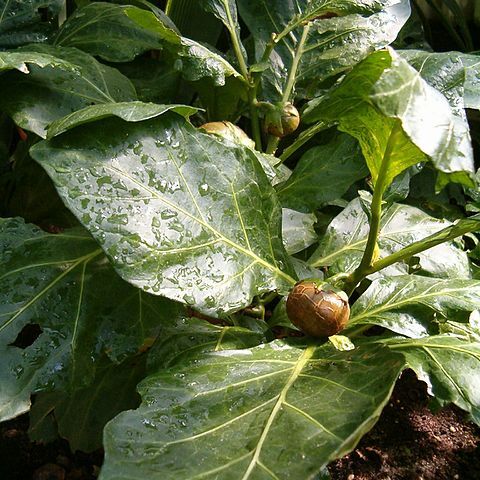Cymes lateral, unbranched, sub-umbelliform or racemiform, 2–6-flowered, usually the lowest flower(s) larger and more prickly, sometimes all flowers unarmed, sometimes flowers solitary; peduncle 0–2 cm long, ± prickly to quite unarmed; pedicels 0.5–3 cm long, slender but somewhat stout in fertile flowers, ± prickly or unarmed, erect or ± curved, in fruit elongated to 4 cm, strongly thickened chiefly distally and robust, recurved or deflexed.
Erect, often much branched, annual to perennial herb or shrub to 1.5 m high, armed or rarely unarmed in some cultivars; hairs stellate, long stalked to sessile, long-radiate, sometimes with a long ray and occasionally appearing simple, rarely absent except for a few minute, simple, glandular hairs when young; prickles straw-coloured becoming fuscous upwards, to 18 mm long, straight, subulate from a ± broad base, glabrous.
An annual plant. It can keep groing for some years. The leaves are dark green and glossy. The leaf stalk is not well defined as the leaf blade runs down into the stalk. Leaves are generally not very hairy. The flowers are purple or sometimes white. The flowers are large. The fruit are are round and greenish white but become orange-yellow or brown when fully ripe. They are hard or firm with long calyces around the fruit.
Ovary 1.5–2.5 mm in diameter, ± globose, glabrous except for a few sparse, minute, glandular hairs near the top, 4–6-locular; style 7–10 mm long, much shorter in male flowers, ± robust, recurved to the apex, sparsely hairy often with a few uniradiate hairs and also or only with a few glandular ones near the base.
Corolla bluish to purple or occasionally white, 1.6–2.5 cm across, broadly campanulate to rotate-stelliform; lobes broadly triangular, abruptly ending in a short, hairy mucro, densely clothed with long-radiate hairs on the median region outside and with a few stellate hairs on the midrib to quite glabrous inside.
Calyx densely clothed with ± stalked and long-radiate stellate hairs to glabrous, ± prickly or unarmed, in fruit strongly enlarged, appressed to and often enveloping it, very prickly; tube 3–4 cm long, campanulate; lobes foliaceous, 8–15 mm long, elongating to 4 cm in fruit, lanceolate-subulate, sub-acuminate.
Fruit ± glossy, at first green-white, later yellow, golden-yellow or orange-yellow, 3–4 cm in diameter or 3–4 × 3.5–4.5 cm, globose or depressed-globose, glabrous, bitter but edible in some cultivars when cooked.
Stamen filaments 1–2 mm long; anthers 5–8 mm long, oblong to lanceolate in outline or broadly lanceolate-ellipsoid, emarginate at both ends or cordate basally.
Seeds pale yellow-brown or yellowish, 3–4 × 2.5–3 mm, oblique or flattened lenticular, subreniform, conspicuously or minutely reticulate all over.
Branches sometimes dark purple, with dense to sparse indumentum and generally with scattered prickles.
Half-woody usually unarmed undershrub with rather stout branches up to 5 ft. high
Flowers 3/4-1 in. diam., white or bluish-purple
Hairy or sometimes glabrescent
Flowers 5(6)-merous.
Often cultivated.

